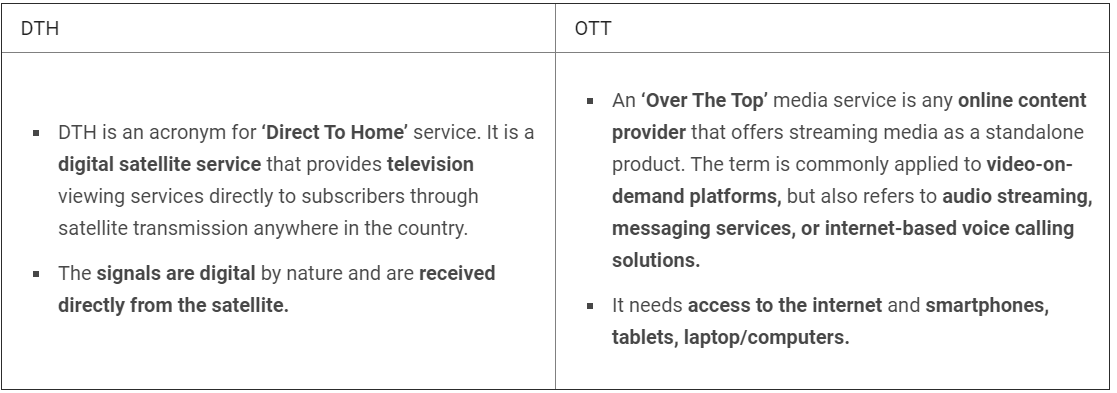Indian Economy
100% FDI in DTH Services
- 26 Dec 2020
- 7 min read
Why in News
The Ministry of Information and Broadcasting (I&B) has recently approved revised guidelines for Direct-to-Home (DTH) broadcasting services, allowing 100% Foreign Direct Investment (FDI) as well as increasing the licence period to 20 years.
- Direct-To-Home (DTH) Broadcasting Service refers to the distribution of multi channel TV programmes in Ku Band by using a satellite system by providing TV signals direct to subscribers' premises.
- Ku-band is a portion of the electromagnetic spectrum. It is best known for its use in satellite broad`cast communications. Ku-band falls in the middle in terms of frequency, utilizing the approximate range of 12-18 GHz of radiofrequency.
Key Points
- License Duration:
- The licenses will be issued for a period of 20 years, compared to 10 years at present and will be renewed for a 10-year period.
- License Fee:
- The license fee has been revised from 10% of Gross Revenue (GR) to 8% of Adjusted Gross Revenue (AGR), which will be calculated by deduction of GST from GR.
- Adjusted Gross Revenue (AGR) is the usage and licensing fee that telecom operators are charged by the Department of Telecommunications (DoT).
- It is divided into spectrum usage charges and licensing fees.
- Further, broadcasting firms will have to pay the license fee on a quarterly basis, rather than the annual basis as of now.
- The license fee has been revised from 10% of Gross Revenue (GR) to 8% of Adjusted Gross Revenue (AGR), which will be calculated by deduction of GST from GR.
- Infrastructure Sharing: The government has also allowed DTH operators to share infrastructure.
- Distributors of TV channels will be permitted to share the common hardware for their Subscriber Management System (SMS) etc.
- SMS is a server important for cable TV digital systems.
- Distributors of TV channels will be permitted to share the common hardware for their Subscriber Management System (SMS) etc.
- Benefits:
- The revised guidelines may also enable DTH service providers to invest for more coverage leading to increased operations and higher growth and thereby enhanced and regular payment.
- Sharing of infrastructure by the DTH operators, may bring in more efficient use of scarce satellite resources and reduce the costs borne by the consumers.
- Background:
- The Ministry of Commerce and Industry had previously spoken of 100% FDI in the DTH sector, but because of the guidelines issued by the Information and Broadcasting [I&B] Ministry, the FDI was limited to 49%.
- Recently, the Telecom Regulatory Authority of India (TRAI) has also recommended that all Set Top Boxes (STBs) in the country must be made interoperable in order to promote overall sector growth.
- The reduction in the licence fee was recommended by Telecom Regulatory Authority of India (TRAI) in 2014.
- The DTH operators have been arguing that, since TRAI issued the New Tariff Order (NTO) for television in 2019, they have become mere carriers of channels and bouquets, with no pricing powers for these.
- The rise of Over The Top (OTT) services also seems to have impacted the DTH subscription numbers. With high competition in the segment, OTT service providers give consumers a combination of both attractive content and subscription packages.
Foreign Direct Investment
- It is an investment from a party in one country into a business or corporation in another country with the intention of establishing a lasting interest.
- Lasting interest differentiates FDI from foreign portfolio investments, where investors passively hold securities from a foreign country.
- Foreign direct investment can be made by expanding one’s business into a foreign country or by becoming the owner of a company in another country.
DTH v/s OTT
- Decline in DTH Services:
- According to a recent report by the Telecom Regulatory Authority of India (TRAI), the average active subscriber base of DTH services has seen a sharp decline of 25% coming down to 54.26 million in April to June quarter in comparison to 72.44 million in January to March of 2020.
- A recent survey suggests that almost 55% Indians prefer OTT over DTH services and almost 87% of Indians use mobile to watch videos these days.
- Convenience of OTT:
- The convenience and ease with which OTT platforms can be watched makes it more attractive. Mobile phones can be carried anywhere and the user can watch anything of the choice anywhere, anytime given the data availability.
- OTT platforms seem a better option in comparison to high tariffs and the tedious process of choosing the channel combinations in the DTH.
- Economical Data Services:
- The cost of data services have gone down drastically in the last few years which has raised the number of average users including the rural areas as well.
- Because of the availability of internet and ease of carrying smartphones, tablets or laptops, there is consumption irrespective of relatively higher charges for OTT platforms like Netflix and Amazon Prime which shows people’s demand and interest in them.
Way Forward
- India is one of the biggest single markets for audiences, with an estimated 200 million cable and satellite households. Whether OTT will take over the DTH market or not, it depends on various factors. One of them is the dependency on the internet connection in OTT platforms which is still uneven and not accessible to more than half the people of India.
- Roughly two-third of India does not actively use the internet so OTT choices become very limited. So the whole idea of OTT taking over DTH or cable connections is a little premature.
- The broadcasters must realise that audiences are won by the power of authentic programming and entertainment. In a diverse cultural milieu, with a vibrant public sphere and a sporting tradition, there is space for everyone, and the best combination of technology and pricing will win the viewer’s favour.







